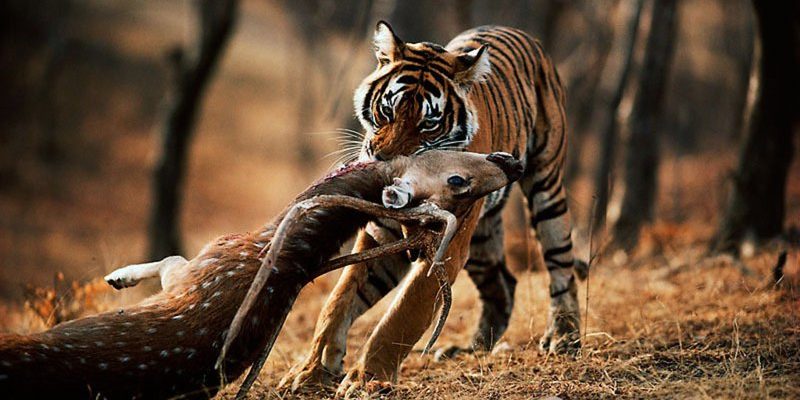
When you think about a tiger’s diet, you might picture them prowling through dense forests, stealthily stalking their prey. In reality, their hunting techniques are as varied and impressive as their striped coats. They are not just mindless hunters; they possess a combination of skill and patience that makes them successful in the wild. So, what exactly does a tiger eat, and how do they manage to catch such elusive prey?
Understanding the Tiger’s Diet
Tigers are carnivores, meaning their diet primarily consists of meat. But what kind of meat are we talking about? Tigers have a varied diet, feeding on a range of animals depending on their habitat. You might find them munching on:
- Deer (like sambar and barasingha)
- Wild boar
- Buffalo
- Smaller mammals such as rabbits and monkeys
This variety ensures that tigers can adapt to different environments, whether they’re roaming the grasslands or the thick, humid jungles of Southeast Asia. Honestly, each meal is a part of a delicate balance in their ecosystem, influencing populations of other species and shaping the environment they inhabit.
Hunting Techniques of the Tiger
Let’s get into the nitty-gritty of how tigers actually hunt their prey. They are known for their stealth, often using their stripes to blend into the surroundings. Picture a master ninja, quietly sneaking up on its target. Tigers employ a few core techniques when hunting:
- Stalking: Tigers rely heavily on their ability to remain undetected. They move slowly and quietly, often hiding behind the brush.
- Ambush: This is a classic technique. They’ll get as close as possible before pouncing, using the element of surprise to their advantage.
- Strength: Once they catch their prey, their sheer power helps them take down animals much larger than themselves.
In many cases, a tiger’s success hinges on patience. They can spend hours or even days waiting for the perfect moment to strike, carefully observing their surroundings. You might be wondering how they know when to attack. Generally, they look for signs of vulnerability in their prey, such as isolation or weakness.
Feeding Habits and Meal Size
Tigers are known to consume large amounts of meat in a single sitting—sometimes up to 60 pounds! That’s roughly the weight of a small dog. Their feeding habits are shaped by their natural instincts and the availability of food. After a successful hunt, they often gorge themselves, knowing that food may not be plentiful in the future.
Interestingly, tigers generally feed alone rather than in groups. This solitary dining style helps reduce competition and ensures that they consume enough to sustain their energy levels. After feasting, they often cover the remains of their kill with leaves or dirt to protect it from scavengers. Imagine a tiger taking the time to wrap up its leftovers—pretty clever, right?
Importance of Territory and Hunting Grounds
A tiger’s territory plays a crucial role in its diet and hunting strategy. They need a large area to roam in search of food. Male tigers typically have larger territories than females, allowing them access to a wider range of prey.
Territorial boundaries are marked by scent markings, scratch marks on trees, and vocal calls. By establishing their territory, tigers ensure they have enough resources to survive while minimizing conflicts with other tigers. Keep in mind that habitat loss and fragmentation are significant threats to tiger populations. The more we encroach on their natural habitat, the harder it becomes for them to find food.
Adaptations that Aid in Hunting
Tigers have several unique adaptations that make them exceptional hunters. Here are a few standout features:
- Vision: Tigers possess excellent night vision, allowing them to see in low-light conditions. This is especially helpful during dawn and dusk when many animals are active.
- Hearing: They have keen hearing, which helps them detect the subtle sounds of prey moving through the forest.
- Muscle Power: Their powerful legs and strong jaws give them the ability to leap great distances and hold onto their prey with immense strength.
These adaptations not only enhance their hunting prowess but also ensure they can compete effectively in the wild.
Impact of Diet on Tiger Conservation
As top predators, tigers play a vital role in maintaining the balance of their ecosystems. Their hunting habits help keep herbivore populations in check, which in turn supports vegetation and overall biodiversity. However, threats like poaching and habitat destruction severely affect their diet and, consequently, their survival.
Conservation efforts focus on protecting their natural habitats and the prey species they depend on. Healthy populations of deer and other animals are essential for tigers to thrive. When you support these initiatives, you’re helping ensure that these magnificent creatures continue to roam the wild, hunting in their natural way.
The diet and hunting strategies of the tiger offer a fascinating glimpse into the life of one of nature’s most skilled hunters. From their impressive stalking techniques to their solitary feeding habits, tigers have adapted perfectly to their environment. Understanding their needs and behaviors is crucial, especially as we work to protect them in a rapidly changing world.
So, the next time you find yourself captivated by a tiger’s striking gaze, remember the intricate dance of survival happening behind those eyes. Their role in the ecosystem is invaluable, and through awareness and conservation efforts, we can help ensure that tigers remain a vital part of our natural world.

